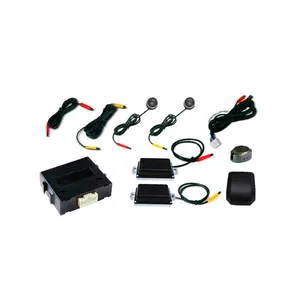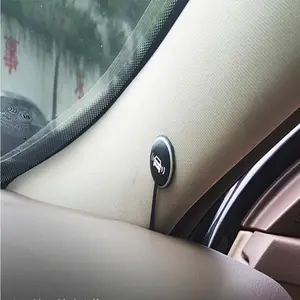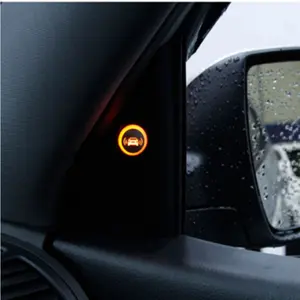(338 products available)

































































































































































 Ready to Ship
Ready to Ship








































The reverse assistant mirror parking sensor is a helpful tool for drivers, particularly those in larger vehicles. It enables them to reverse and park safely and accurately. The system often comprises multiple components that work together to provide a comprehensive view and alert system. It includes parking sensors, reverse cameras, and smart mirrors. Each component has its own distinct function.
Parking Sensors
One common element of many reverse assistance systems is parking sensors. These sensors detect obstacles when the vehicle is reversing. They emit a high-frequency sound wave. When the sound wave encounters an obstacle, it bounces back. The system then detects the change in frequency and alerts the driver through an audible warning. The tone of the warning changes based on the proximity of the vehicle to the obstacle. It becomes more frequent as the driver gets closer to the object.
Reverse Cameras
Another important feature of the reverse assistant system is the reverse camera. The camera provides a live video feed of the area behind the vehicle. It is mounted on the rear bumper or emblem of the car. Additionally, it can detect obstacles that may not be visible in the mirrors. The camera works in conjunction with the parking sensors. While the sensors provide distance information, the camera offers visual information. Together, they enhance safety and convenience when reversing.
Smart Mirrors
Smart mirrors integrate with reverse assistant systems to provide additional functionality. These mirrors can display the feed from the reverse camera. They may also show relevant information like distance to obstacles or the vehicle's surroundings. Some smart mirrors have parking guidelines that help drivers estimate distances and angles when parking. They assist in making precise maneuvers in tight spaces.
Cross-Traffic Alert
Cross-traffic alert is a useful feature, especially in crowded parking lots. This feature warns drivers of approaching cross traffic when reversing. It utilizes additional sensors or radar systems to detect vehicles moving across the path of the reversing vehicle. The system alerts the driver through visual indicators or audible warnings.
Pedestrian Detection
Some advanced reverse assistant systems include pedestrian detection technology. This technology can identify pedestrians near the vehicle's rear when reversing. If the system detects a potential collision risk, it can alert the driver or even apply the brakes automatically.
Automatic Emergency Braking
Automatic emergency braking is a crucial safety feature in modern vehicles. It can help prevent or reduce the severity of rear-end collisions. If the driver fails to respond to an obstacle while reversing, the system can apply the brakes automatically.
Integrating Technologies
Many modern reverse assistant systems combine parking sensors, reverse cameras, smart mirrors, and other technologies. This integration provides comprehensive support for drivers when reversing. It improves safety, reduces stress, and enhances overall driving experience.
Regular Inspection:
Conduct regular inspections of the parking sensor system. Look for cracks, chips, or damage to the sensors, wiring, and control module. Damage can interfere with sensor performance. Visually inspect the reverse assistant mirror for tears or damage to the reflective film. Damaged films may reduce visibility.
Regular Cleaning:
Regularly clean the parking sensors and reverse assistant mirror. Use a damp cloth or mild cleaner to remove dirt, dust, and debris that may affect their accuracy. Avoid using abrasive materials that could scratch the sensors or mirror surface. Clean the sensor lenses gently with a soft microfiber cloth. Avoid using harsh chemicals or abrasive materials that could scratch the sensor lenses.
Proper Use:
Only engage the parking sensors when reversing or parking. Continuous activation can cause unnecessary wear and tear. Avoid excessive force when adjusting the reverse assistant mirror. Over-adjustment can damage the mirror's internal components.
Software Updates:
Check with the vehicle manufacturer for any software updates for the parking sensor system. Updated software can improve performance and accuracy. Follow the manufacturer's recommendations for adjusting and positioning the reverse assistant mirror. Incorrect positioning can reduce its effectiveness.
Professional Inspection:
If any issues are suspected with the parking sensor system, have it inspected by a qualified technician. They can diagnose and repair any problems. If the reverse assistant mirror is not functioning correctly, consider professional inspection and replacement if needed.
Retailers should consider several factors when sourcing reverse assistant mirrors with parking sensors to meet various customers' needs. They include;
Vehicle Compatibility
It is vital to consider the customers' car types and models. Some mirrors are universal and can fit in various vehicles, while others are specific to a given model. The sensors and mirrors also mount and integrate differently in various cars.
Quality and Reliability
To satisfy clients, it is important to source high-quality reverse assistant mirrors. The quality will ensure durability and reliability of the mirrors and sensors. The sensors should provide accurate distance measurements and object detection to prevent accidents when reversing.
Ease of Installation
The reverse assistant mirrors and parking sensors should be easy to install. This will enable customers who are DIYs to fix them themselves without professional help. Suppliers should provide clear installation instructions and source models that are simple to install.
Display Quality
Retailers need to consider the display quality in the reverse assistant mirrors. The displays should be sharp with good resolution and brightness. They should also be large enough to ensure clear visuals of the surroundings. Additionally, one should source models with anti-glare features.
Durability and Weather Resistance
Reverse sensors and parking mirrors are exposed to various weather conditions. Therefore, they should be made of materials that are not easily damaged by extreme temperatures, moisture, or UV rays. The models sourced should be robust to ensure longevity.
Adjustability
Retailers should consider the mirrors and sensor systems that are adjustable. Not all vehicles are of the same height. Adjustable features will enable the sensors and displays to fit perfectly in different cars. They will also ensure optimal performance.
Additional Features
Some additional features in reverse assistant mirrors may be important to some clients. Retailers should be on the lookout for models with integrated features. They include Bluetooth for hands-free calls, GPS navigation, and lane departure warning systems. Such features will enhance overall safety and convenience.
Budget and Value for Money
It is important to compare various models and their features to ensure value for money. Additionally, retailers should source products that will give their customers value for every coin they spend. The features and quality should match the price charged.
Some reverse sensors are easy to install, so manufacturers include DIY kits. If they don't, users might need to hire a professional. Here's a basic overview of how to install a parking sensor with a DIY kit:
If the sensors connect to the mirror, they might connect to the vehicle's auxiliary wiring. It's best to consult an expert to avoid electrical mishaps.
Q1: What is a reverse assistant mirror parking sensor?
A1: A reverse assistant mirror parking sensor is a car technology that helps drivers avoid accidents while reversing. It uses sensors to detect obstacles behind the vehicle and notifies the driver through visual or audible signals. Many vehicles have this feature installed, especially in luxury and high-end models.
Q2: How does a reverse assistant mirror parking sensor work?
A2: The reverse assistant mirror parking sensor has ultrasonic sensors mounted on the vehicle's rear bumper. These sensors emit sound waves and monitor the environment behind the car while reversing. They can detect obstacles and measure their distance using the reflected sound waves. The system alerts the driver through a display screen showing the distance to the obstacle or audible beeps that increase in frequency as the vehicle approaches the obstacle.
Q3: Can the reverse assistant mirror parking sensor be installed in any vehicle?
A3: Yes, the reverse assistant mirror parking sensor can be installed in any vehicle. Various aftermarket models are available and designed to fit different car models and budgets. Consulting a professional installer is essential to ensure compatibility and proper installation of the system in the vehicle.
Q4: Do reverse assistant mirror parking sensors work in all weather conditions?
A4: Reverse assistant mirror parking sensors are designed to function in various weather conditions. However, extreme conditions such as heavy rain, snow, or ice can affect their performance. These elements can obstruct the sensor's sound waves or cover the sensors themselves. It is important for drivers to remain extra cautious and rely on additional visual checks in such conditions.
Q5: Can anything prevent the sensors on a reverse assistant mirror parking system from functioning properly?
A5: Several factors can affect the performance of a reverse assistant mirror parking sensor. These include dirt, debris, snow, or ice obstructing the sensors, damaging the sensors, or interfering with the vehicle's electronic system. Regularly inspecting and maintaining the sensors to ensure optimal function is essential.